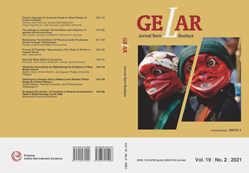Visual Language of Javanese Script on Shoe Design as Cultural Identity
Main Article Content
Abstract
Downloads
Article Details
Copyright
Authors who publish with Gelar: Jurnal Seni Budaya agrees to the following terms:
- Authors retain copyright and grant the journal right of first publication with the work simultaneously licensed under a Creative Commons Attribution License (CC BY-SA 4.0) that allows others to share the work with an acknowledgment of the work's authorship and initial publication in this journal.
- Authors are able to enter into separate, additional contractual arrangements for the non-exclusive distribution of the journal's published version of the work (e.g., post it to an institutional repository or publish it in a book), with an acknowledgment of its initial publication in this journal.
- Authors are permitted and encouraged to post their work online (e.g., in institutional repositories or on their website) prior to and during the submission process, as it can lead to productive exchanges, as well as earlier and greater citation of published work.
References
Adityawan, A., & Consep, T. H. (2010). Tinjauan Desain Grafis. PT Concept Media: Jakarta.
Ardhianto, P. (2016). Tinjauan Desain pada Karya Poster; Studi Kasus Seri Poster “Marlyn Fish 2009.” ANDHARUPA: Jurnal Desain Komunikasi Visual & Multimedia.
https://doi.org/10.33633/andharupa.v2i01.1040
Ardhianto, Peter, Wei-Her Hsieh, Soteria Adia Mahanaim, and Chi-Hsiung Chen. "Cross-Cultural Concepts in Cultural Product Design." In 3rd International Conference on Arts and Design Education (ICADE 2020), pp. 146-149. Atlantis Press, 2021. https://doi.org/10.2991/assehr.k.210203.031
Awalin, F. R. N. (2017). DUNIA BATIN JAWA: Aksara Jawa Sebagai Filosofi dalam Memahami Konsep Ketuhanan. Kontemplasi: Jurnal Ilmu-Ilmu Ushuluddin, 5(2), 289-309.
Chua, R. Y. J., Roth, Y., & Lemoine, J. F. (2015). The Impact of Culture on Creativity: How Cultural Tightness and Cultural Distance Affect Global Innovation Crowdsourcing Work. Administrative Science Quarterly. https://doi.org/10.1177/0001839214563595
Forshee, J. (2006). Culture and customs of Indonesia. Westport, CT: Greenwood Press.
Haryanto. (2014). Media Pembelajaran Interaktif mengenal aksara Jawa dan cara membacanya [Dian Nuswantoro]. http://eprints.dinus.ac.id/12947/2/abstrak_13174.pdf
Huang, C., Yen, S., Liu, C., & Chang, T. (2014). The Relationship Among Brand Equity, Customer Satisfaction, and Brand Resonance To Repurchase Intention of Cultural and Creative Industries in Taiwan. The International Journal of Organization Innovation.
Kim, H., Lee, J. K., Shin, J., & Choi, J. (2019). Visual language approach to representing KBimCode-based Korea building code sentences for automated rule checking. Journal of Computational Design and Engineering. https://doi.org/10.1016/j.jcde.2018.08.002
Lewis, M., Paul, G. F. S, & Fennig, C. D. (Eds). (2015). Ethnologue: Languages Of The World (18th Ed.). Dallas, Tx: Sil International
Moalosi, R., Popovic, V., & Hickling-Hudson, A. (2010). Culture-orientated product design. International Journal of Technology and Design Education. https://doi.org/10.1007/s10798-008-9069-1
Sachari, A., & Sunarya, Y. Y. (2000). Pengantar Tinjauan Desain. July 2000. https://doi.org/10.1016/j.optmat.2015.03.013
Setiawan, Agus, Sulaiman, A. M. (2015). Hanacaraka: Aksara Jawa Dalam Karakter Font dan Aplikasinya Sebagai Brand Image. Ornamen, 12(01), 33=47.
Setyawan, I. (2019). Sikap Generasi “Z” terhadap bahasa Jawa: Studi kasus pada anak-anak usia Sekolah Dasar di kota Semarang. Jurnal Ilmiah Komunikasi Makna, 7(2), 30–36. https://doi.org/10.30659/JIKM.7.2.30-36
Mulyono, Suyadi. (2004). Konsep Manusia Dalam Sastra Jawa Hana Caraka. Universitas Gajah Mada. Yogyakarta.
Sprinkle, J., & Karsai, G. (2004). A domain-specific visual language for domain model evolution. Journal of Visual Languages and Computing. https://doi.org/10.1016/j.jvlc.2004.01.006
Venny Indria Ekowati. (2012). Javanese Letters: Symbols Of Javanese Civilization: (Introductio N, History, Philosophical Values, Learning Methods, Utilizations, To Uch Of Technology In Javanese Letters). 1st Mae Fah Luang University International Conference 2012, 66(1975), 37–39.
http://mfuic2012.mfu.ac.th/electronic_proceeding/Documents/00_PDF/O-SSH/O-SSH-21_Venny_Indria.pdf
Voutsina, C. (2018). A practical introduction to in-depth interviewing. International Journal of Research & Method in Education. https://doi.org/10.1080/1743727x.2017.1419693
Wardoyo, S., Kuntari, W., Pramudyo, A. S., Suhendar, & Hidayat, S. (2018). The development of javanese language teaching materials through introduction of java scripts using artificial neural network. Telkomnika (Telecommunication Computing Electronics and Control). https://doi.org/10.12928/TELKOMNIKA.v16i4.8465
Winit, W., Gregory, G., Cleveland, M., & Verlegh, P. (2014). Global vs local brands: How home country bias and price differences impact brand evaluations. International Marketing Review. https://doi.org/10.1108/IMR-01-2012-0001
Yulianto, N.S. & Pudjiastuti, T. 2001. Aksara in Sedyawati, E., Wiryamartana, I.K., Damono, S.D., Adiwimarta, S.S. (pnyt.). Sastra Jawa Suatu Tinjauan Umum, 199- 206. Jakarta: Balai Pustaka.
